AMD Radeon RX 6800, 6800 XT, and 6900 XT aim at Nvidia's best - villanuevafroce1969
Receive back up to the high end, AMD.
First since the years of the Radeon R9 290X—heptad long years ago—AMD's Radeon mathematical group is equipped to unleash partizan-level graphics card game that can do battle with Nvidia's best and brightest. During the company's second "Where Gaming Begins" event on Wednesday, AMD unconcealed a triple of Radeon GPUs supported a new RDNA 2 architecture, all armed with "revolutionary Eternity Cache" technology, enthusiastically time speeds, and interesting synergies with Ryzen. They take train draw a bead on at Nvidia's RTX 30-series offerings, culminating in a $999 Radeon RX 6900 XT that seeks to seize the gaming peak from the grotesque $1500 GeForce RTX 3090 when it launches December 8—for $500 fewer than Nvidia's beastly GPU costs.
The $579 Radeon RX 6800, meanwhile, will fit toe-to-toe with the $500 RTX 3070 cathartic tomorrow, and the $649 Radeon RX 6800 XT intends to challenge the $700 RTX 3080. Both launch November 18, about two weeks after AMD's Ryzen 5000 CPUs hit the streets.
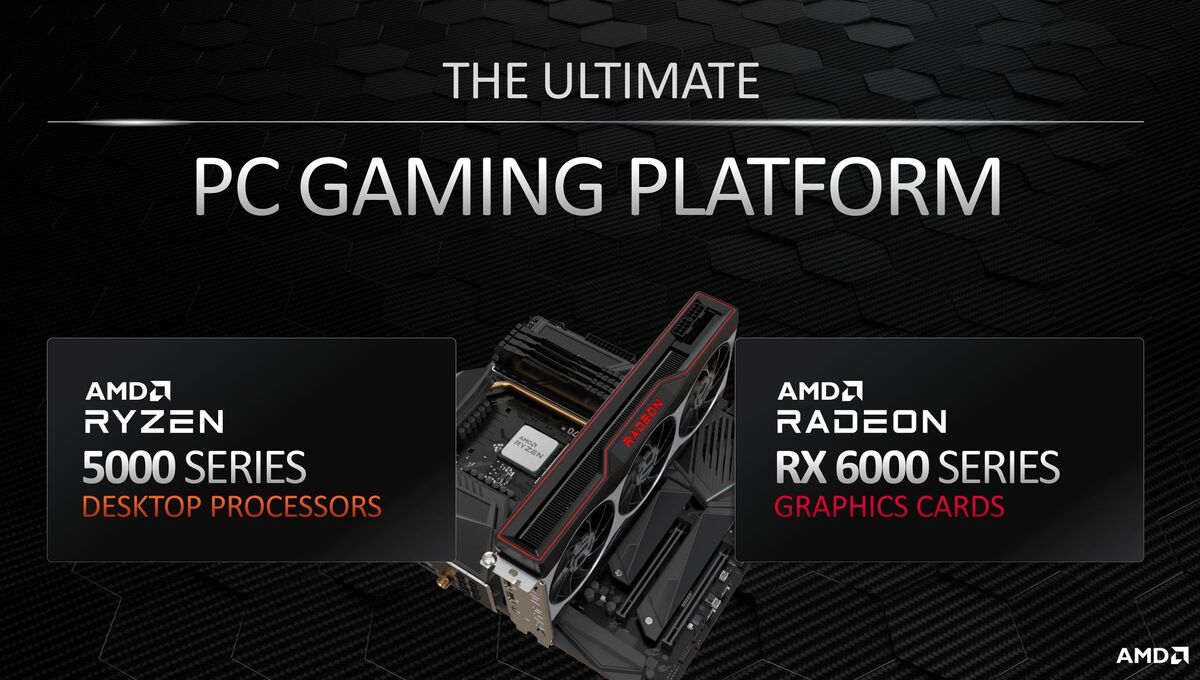 AMD
AMD While Nvidia's recent gaming GPU releases went unhorse with bleak memory capacity, opting for an upgrade to quicker GDDR6X VRAM instead, AMD panoplied all high-level-death Radeon RX 6000 card with a substantial 16GB of standard GDDR6, plenty to handle 4K gaming well into the future. And while Nvidia's RTX 3080 and 3090 consume more more power than previous GeForce incarnations, AMD claims it's achieved its exalted goal of a 50 percent public presentation-per-watt increase compared to the pilot RDNA architecture, which makes the Radeon RX 6000-series XT graphics cards less power-hungry than their Nvidia rivals.
Yes, you record that in good order: Radeon GPUs wish need less major power than competing GeForce cards. My, how the tables have turned.
We'll start by diving into the unprocessed spectacles and performance claims for the Radeon RX 6800, 6800 XT, and 6900 XT, because we know that's what you're here for, but stick around afterward when we probe fundamental changes in the RDNA 2 architecture and unexampled Radeon ecosystem features, like Smart Get at Retentivity that ties into Ryzen 5000 CPUs and AMD's new Infinity Cache. Those provide crucial additional context for some of the slides you're most to see.
Radeon RX 6800 vs. GeForce RTX 3070
 AMD
AMD Let's start at the more affordable end.
The Radeon RX 6800 packs 60 compute units and a 1,815MHz game clock—90MHz high than the rival GeForce RTX 3070's rated Boost belt along. More than importantly, AMD's card triumphs in memory board capacity, packing a full 16GB of GDDR6 RAM versus the 3070's 8GB. Nvidia pitched the 3070 as the ultimate 1440p graphics circuit board, merely it can practise well in 4K games, too. That 8GB store pilo probably won't clasp up well for 4K gaming as the years go on though, as any games already exceed IT. The Radeon RX 6800 North Korean won't ache the same problem. Nvidia's bill of fare enjoys a slightly lower total board power rating.
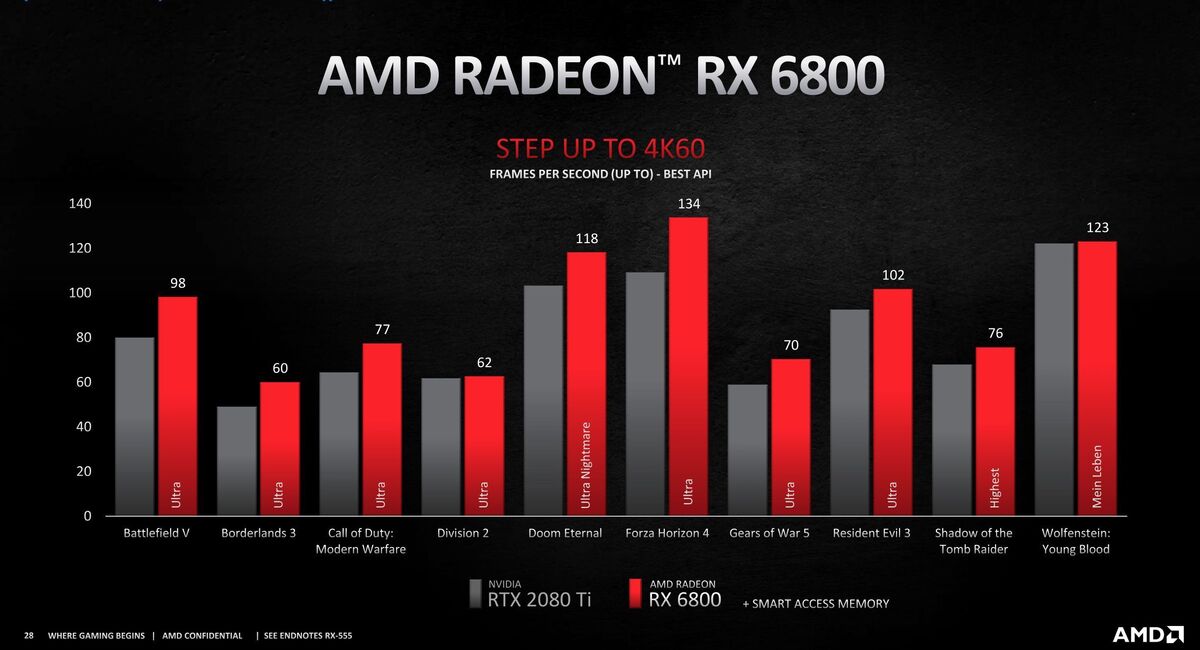 AMD
AMD 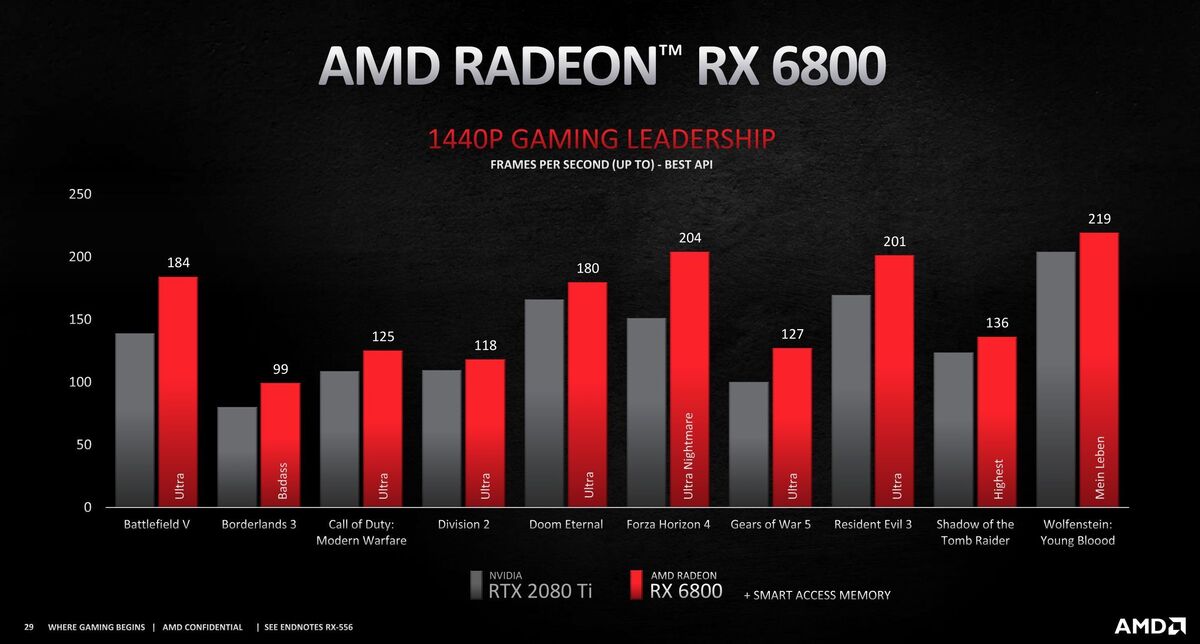 AMD
AMD Today things are getting interesting. Vendor benchmarks should always be taken with a caryopsis of SALT, and you should always wait for self-sustaining reviews of pricey hardware, but AMD's data tends to be tried and true—and it shows the Radeon RX 6800 drubbing the GeForce RTX 3070 across the board here, at both 4K and 1440p resolution. Wow. Radeon chief Scott Herkelman told me that AMD's lab put-upon identical systems for all tests, dynamic only the artwork batting order, and that the company used the best-performing API for a given nontextual matter card altogether tests. So if Nvidia's GPU performed better in a game victimisation DirectX 11, and AMD's exceled with DX12, these results reflect apex functioning.
IT's non quite atomic number 3 cut-and-dry Eastern Samoa it looks, withal. See that tiny "+Wise Access Memory" future to the Radeon RX 6800's discover at the stern? This graphs shows AMD performance therewith feature active, which throne provide an additional performance boost when you drop a Radeon 6000 GPU into a system with a Ryzen 5000 CPU installed. We'll fetch into it more later, merely these aren't stock results for the RX 6800.
Radeon RX 6800 XT vs. GeForce RTX 3080
 AMD
AMD Stepping up the muckle, the Radeon RX 6800 Crosstalk increases the compute unit look to 72, gamey clock speeds to a hair over 2GHz, and the amount board power to 300 watts. It also offers a roomy 16GB of memory. By comparison, Nvidia's GeForce RTX 3080 has a Rise clock nearly 300MHz slower (though it tends to run quicker actually) and just 10GB of storage, though it uses the faster GDDR6X variety for more bandwidth. The Radeon RX 6800 XT's 300W power rating is 20W to a lesser degree the RTX 3080's.
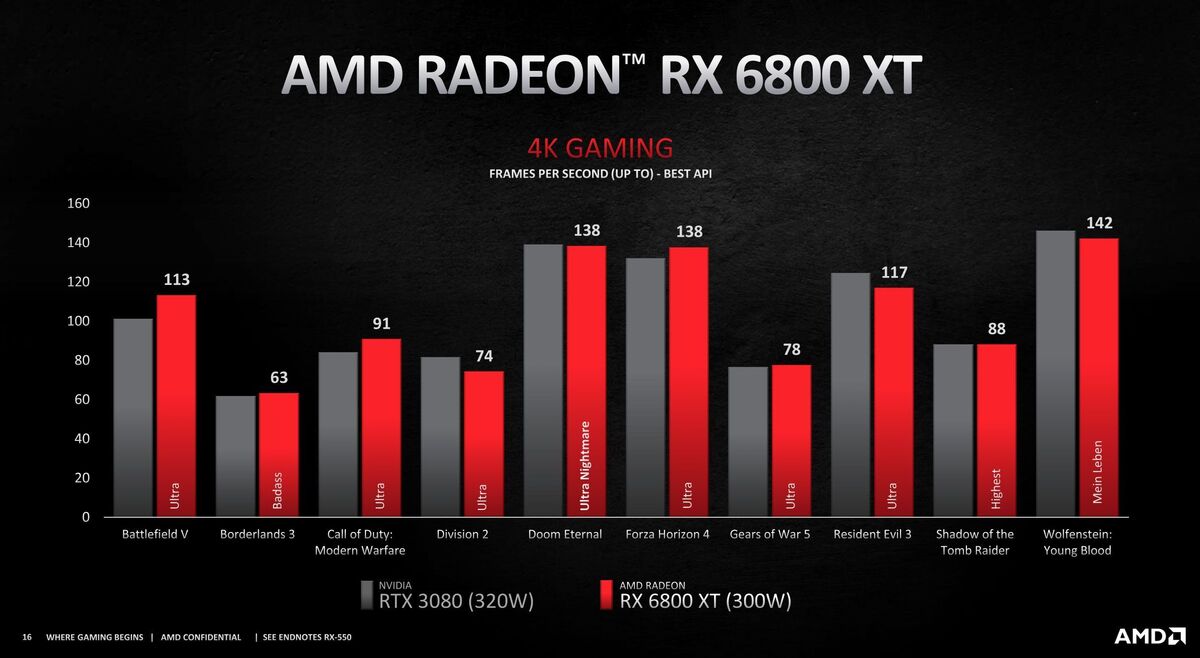 AMD
AMD 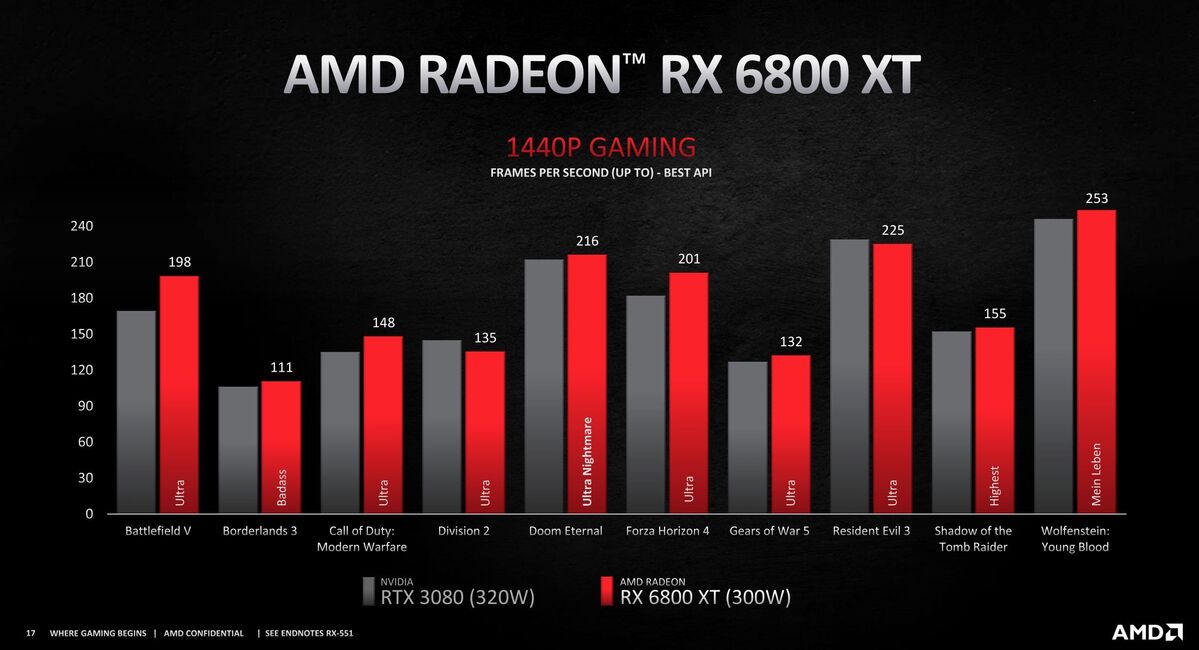 AMD
AMD In these results, AMD isn't putting its thumb on the scale with Smart Access Retentiveness. In its stockpile state, the Radeon RX 6800 XT meets operating theater flat-out beats the GeForce RTX 3080 in 7 of the 10 benchmarks here at 4K resolution, where Nvidia's card performs its best. Fall the resolution to 1440p, where Nvidia's International ampere can't take full vantage of its abundant shaders, and AMD opens its lead even Thomas More, triumphing in all courageous omit Sectionalisation 2 and Resident Evil 3. Hot beshrew.
Radeon RX 6900 Crosstalk vs. GeForce RTX 3090
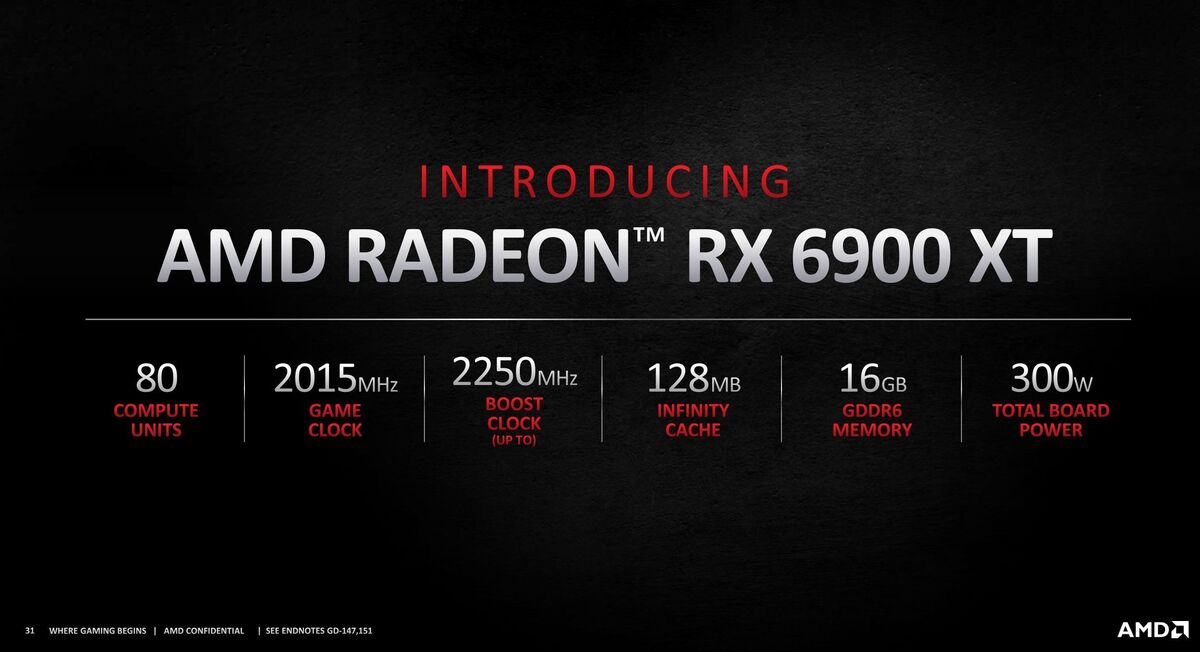 AMD
AMD Now we get to the battle of the (almost) Titans. The Radeon RX 6900 XT packs indistinguishable specifications to the Radeon RX 6800 XT exclude one, boosting the critical compute unit of measurement reckoning from 72 to 80. Yes, it still runs over 2GHz, and yes, IT still sticks to 300W of totality board power—50W to a lesser degree the power-sucking GeForce RTX 3090.
Nvidia's marketing for the 3090 rotated just about 8K gaming and the card's massive, Jehovah-matey 24GB of GDDR6X memory. The company even calls the step-down in the mouth RTX 3080 its gambling flagship—not the 3090. AMD is holding the focal point on normal gamers with the Radeon RX 6900 XT. This card comes with 16GB of standard GDDR6 memory, precisely like the other Radeon GPUs revealed today. It's not as spacious and not as instant as the RTX 3090's memory, but 16GB of GDDR6 should hold up well for 4K gaming over the longsighted term nonetheless. Opting for a less extreme VRAM setup means AMD arse keep the cost of the Radeon RX 6900 XT more than lower compared to its competitor.
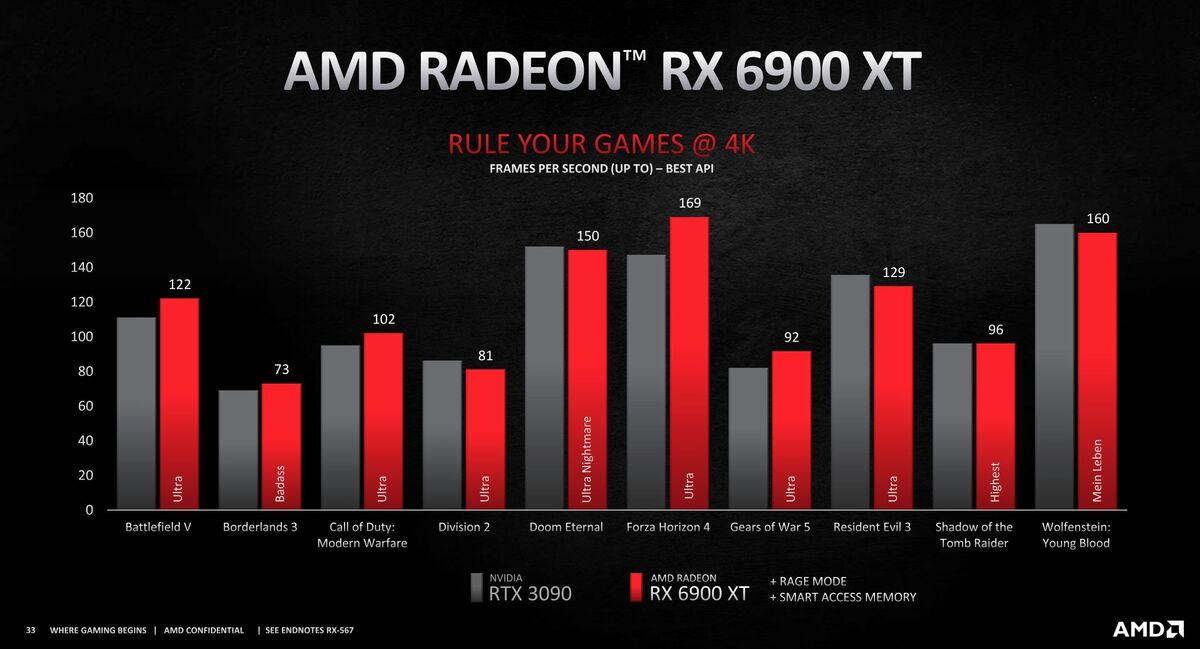 AMD
AMD Thus many people thought this was impossible, but here we are—at least in AMD's supplied benchmarks. The Radeon RX 6900 XT beats or ties the GeForce RTX 3090 more much than non at 4K, and considerably so in Forza, with all games blowing well past the golden 60-frames-per-instant mark even with their highest visual settings enabled.
Bill that AMD is tipping the scales over again here, and more so than before. Not only is Smart Access Storage active connected the Radeon system, but so is Cult, AMD's new automatic overclocking tool in Radeon Software. A victory is a victory, merely you can't facilitate just wonder how very much extra performance those features are adding to the top. A slide you'll see later shows the duo improving performance by anywhere from 2 to 13 per centum depending on the game, with an modal uplift of 6.4 percent crosswise eight games.
It's too worth noting, however, just how much cheaper the Radeon RX 6900 XT is compared to the luxurious GeForce RTX 3090. $500 personal't chump change.
That's it arsenic far as the Radeon RX 6000-series artwork cards themselves go. For a deeper look at the RDNA 2 architecture and new features inside AMD's high-remnant GPUs—including Rage, Smart Approach Memory, and Infinity Cache—keep down reading.
RDNA 2 and Infinity Cache
 AMD
AMD AMD knew that to catch up to Nvidia, its GPUs needed to become much Thomas More economical than they victimised to be. RDNA 1 achieved a 50-percent index improvement all over previous Radeon GPUs, but a humongous part of the efficiency gains came from moving to the advanced 7nm manufacturing process. The RDNA 2 architecture corset on 7nm, so AMD's engineers needed to boost its efficiency by another 50 percent in otherwise ways.
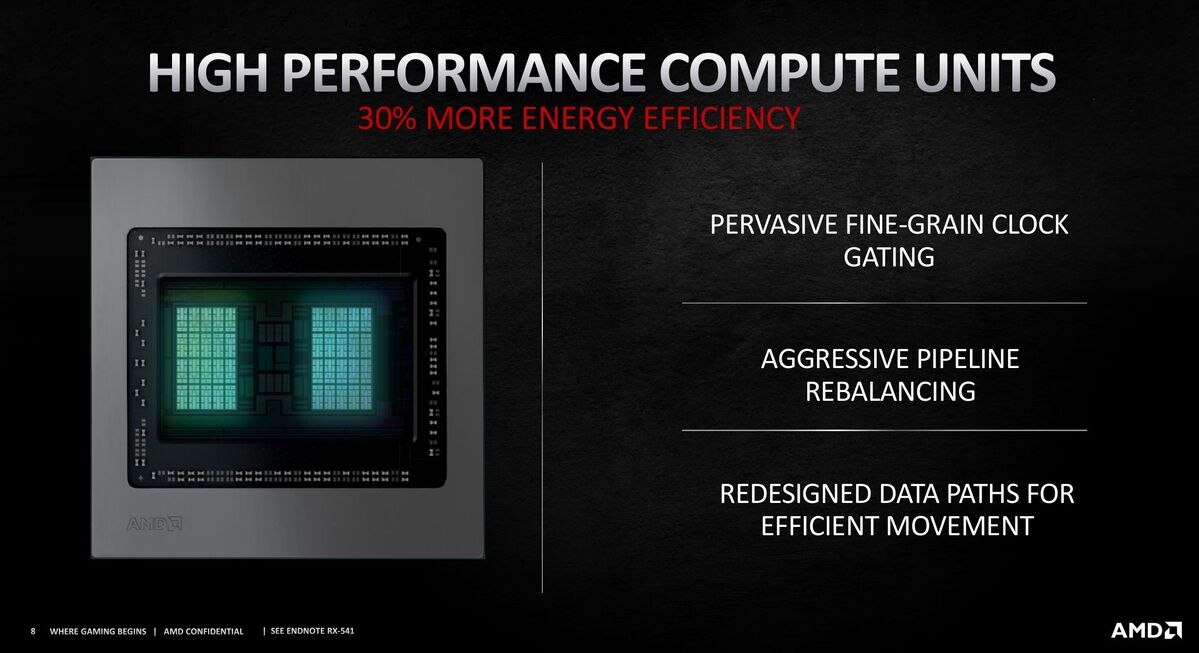 AMD
AMD It started with the compute units—the beating heart of the GPU. AMD's graphics chief engineer, Laura Smith, aforementioned the company went through with the aim with a fine-toothed comb to side unfashionable inefficiencies: rejiggering information paths, rebalancing pipelines, and (in a Sri Frederick Handley Page from the Ryzen design handbook) enabling "pervasive powdered-grain clock gating," which is an interesting twist I'm look fresh to earshot much about, American Samoa GPUs behave very differently than CPUs. The new compute units are 30 percent many efficient than before, which Smith says is deciding for grading RDNA adequate to these enthusiast-sort GPUs.
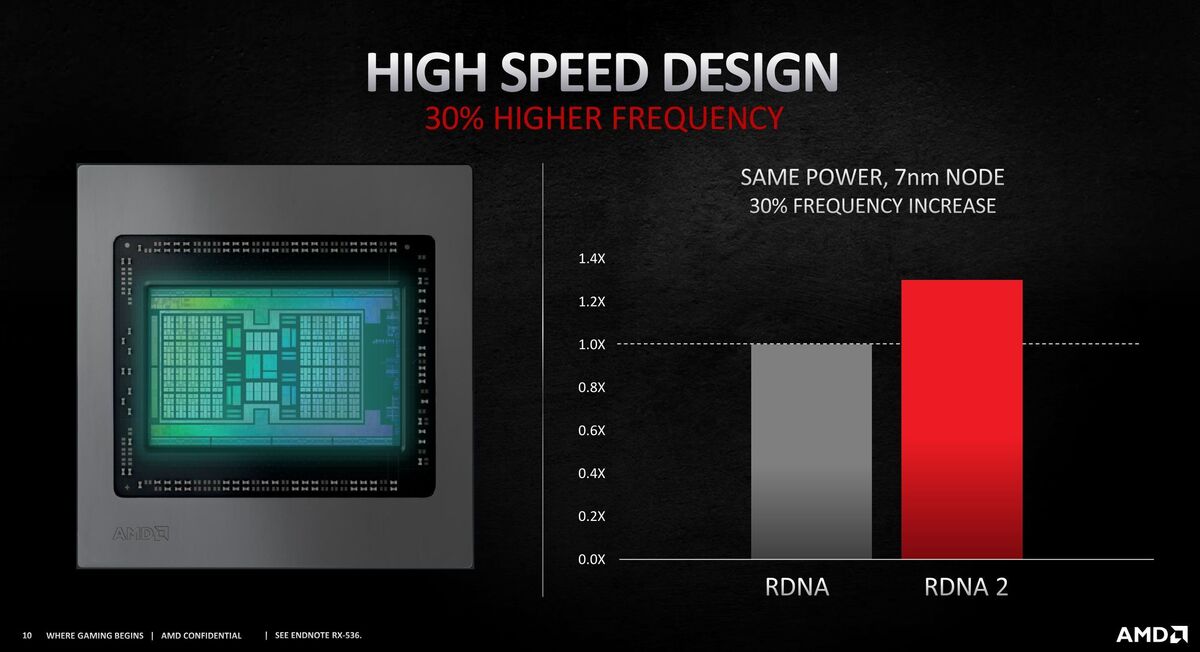 AMD
AMD AMD's engineers also managed to squeeze much higher clock speeds proscribed of RDNA 2 connected the performance side of meat of things. Where the Radeon RX 5700 XT sported a 1,755MHz game clock, AMD says the Radeon RX 6800XT and 6900XT should sustain 2,015MHz speeds during gaming, and can even kick the bucket to 2,250MHz in other tasks. (Smith in reality says the Radeon RX 6900 XT's power-per-watt increase versus RDNA 1 was even higher, at 65 pct.)
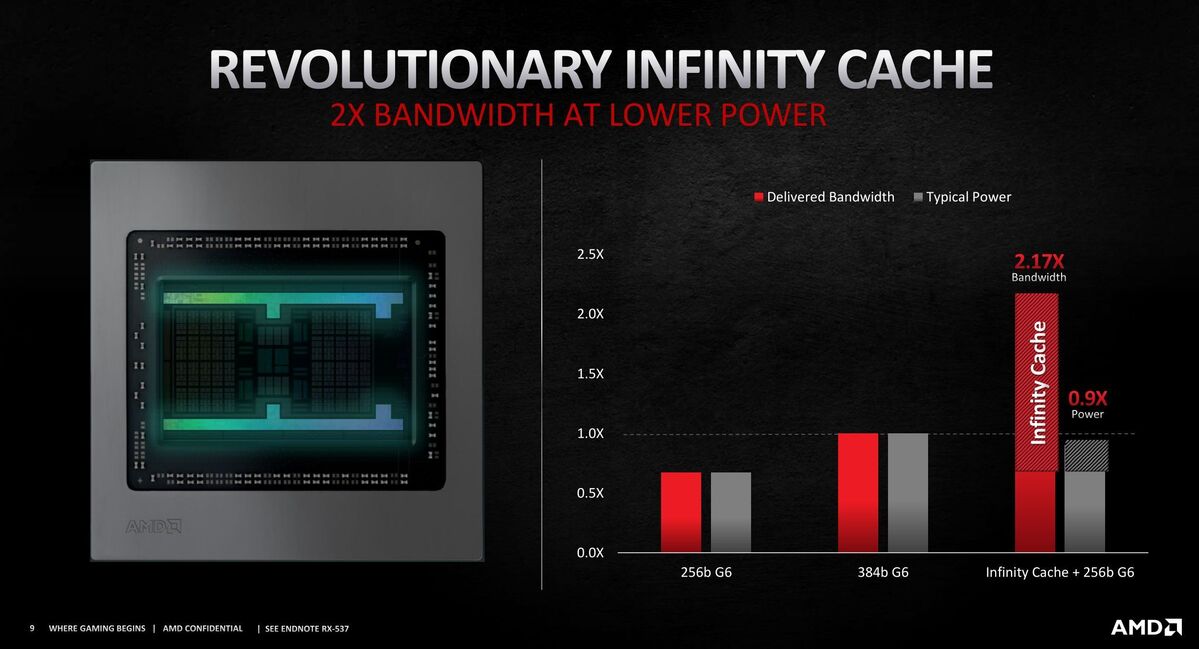 AMD
AMD But the nigh intriguing—and mysterious—power gains come from the new 128MB "Infinity Cache" built into the Radeon RX 6000-series. Smith says the Eternity Cache is a high-density design that has its roots in Ryzen's L3 hoard decisions, but rearchitected for Radeon's gaming needs. Inside information of what Infinity Cache really does remain muddy, simply Smith says it basically allows Radeon RX 6000 graphics cards to deliver twice the computer memory bandwidth at get down power cost. Including Infinity Cache lets AMD stick to a small 256-act bus for the Radeon RX 6000-series, which provides substantial power savings over moving to the larger bus sizes you normally see in high-stepping-end gaming cards. We can't wait to find out—and test—more.
Ryzen synergy, Rage, and DirectX 12 Ultimate
Hardware can't race without software, and part of AMD's introduction was consecrate to showcasing some slap-up modern capabilities found in Radeon RX 6000 art cards. Most intriguing? AMD Smart Access Memory.
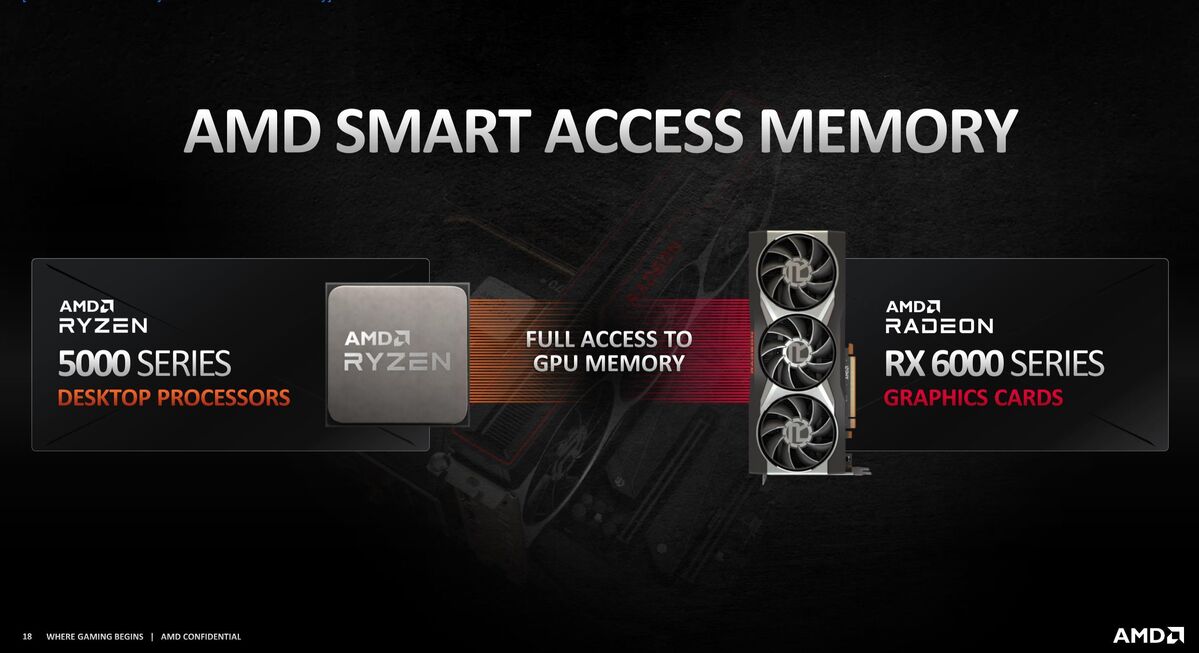 AMD
AMD Like AMD's Smart Shift technology in laptops (and the RDNA 2-based PlayStation 5), AMD Smart Access Retentiveness is designed to give you improved performance if you're every last-in on AMD's hardware. If you have both a Ryzen 5000 CPU and a Radeon 6000 GPU in your system, AMD Smart Access Memory gives your CPU access to your graphics card's full memory buffer, preferably than the usual 256MB chunks. That direct communication cuts down on buffering and expected latency. Even though game makers haven't had a encounter to optimize for the closely guarded tech yet, Radeon chief Scott Herkelman told PCWorld that simply flipping this feature and Ramp overclocking along simultaneously in AMD's labs resulted in performance increases across a series of games, with Forza Horizon 4 running 13 percent faster.
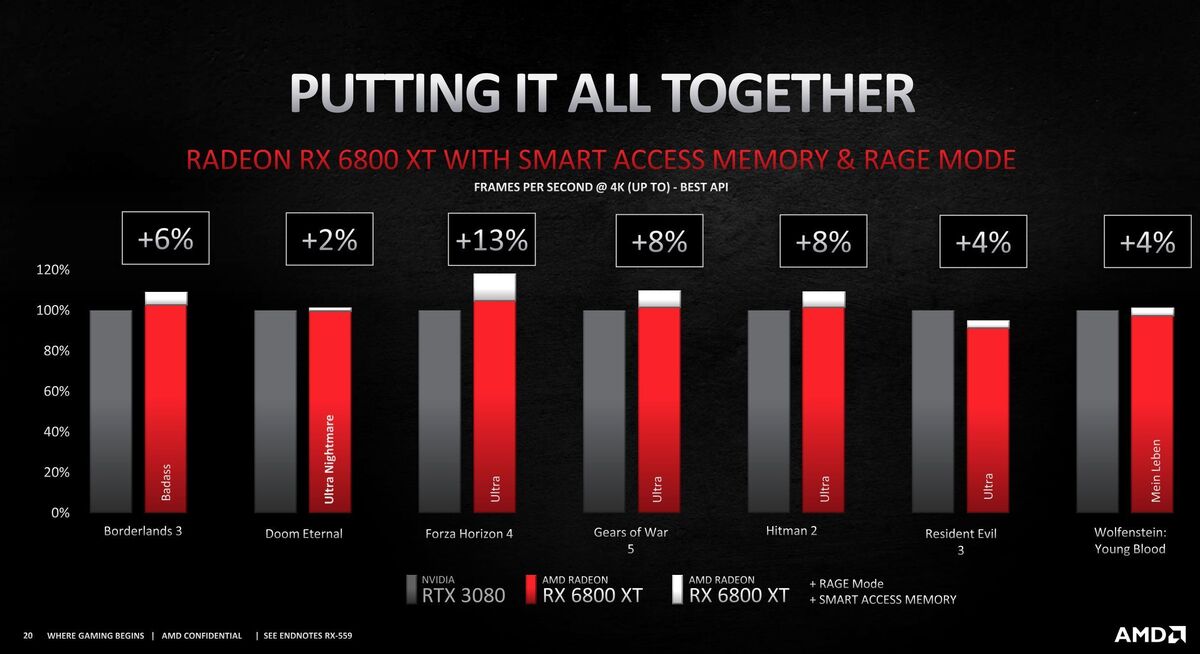 AMD
AMD Fascinating stuff. As with Infinity Hoard, we're looking forward to sighted deeper details, but several AMD-supplied benchmarks for the Radeon RX 6000 GPUs show results from numerous games with Intense Access Memory active.
AMD's new cards will too back Microsoft's upcoming DirectStorage API, which testament allow your GPU talk directly to your NVMe SSD for vastly improved loading times in games. Acquiring the various parts of your PC to talk straight off rather than flowing direct system RAM suddenly seems like the baking hot brand-new trend for 2021. (Nvidia's RTX 30-serial too supports DirectStorage, victimisation "RTX IO" branding.)
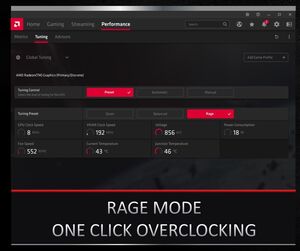 AMD
AMD AMD is also superior up the one-click overclocking capabilities found in its Radeon Software. Going frontward, you'll find a new "Furor" preset tuning choice that applies an automatic overclock tuned to your specific card—a accommodating tool indeed for hoi polloi who just want their games to fiddle as quickly A possible with no headaches. Herkelman told me there are some slight differences compared to the previous automatic overclocking have offered by Radeon software package, but he didn't get into specifics.
Sport fact: The "Rage" name is a shoutout to a popular ancestry of graphics cards released away ATI in the youth of 3D acceleration, before AMD purchased the company. ATI's "Vehemence" moniker made a comeback in graphics card form a few years back, and now Rage volition personify back on every Radeon-powered PC. I dig information technology.
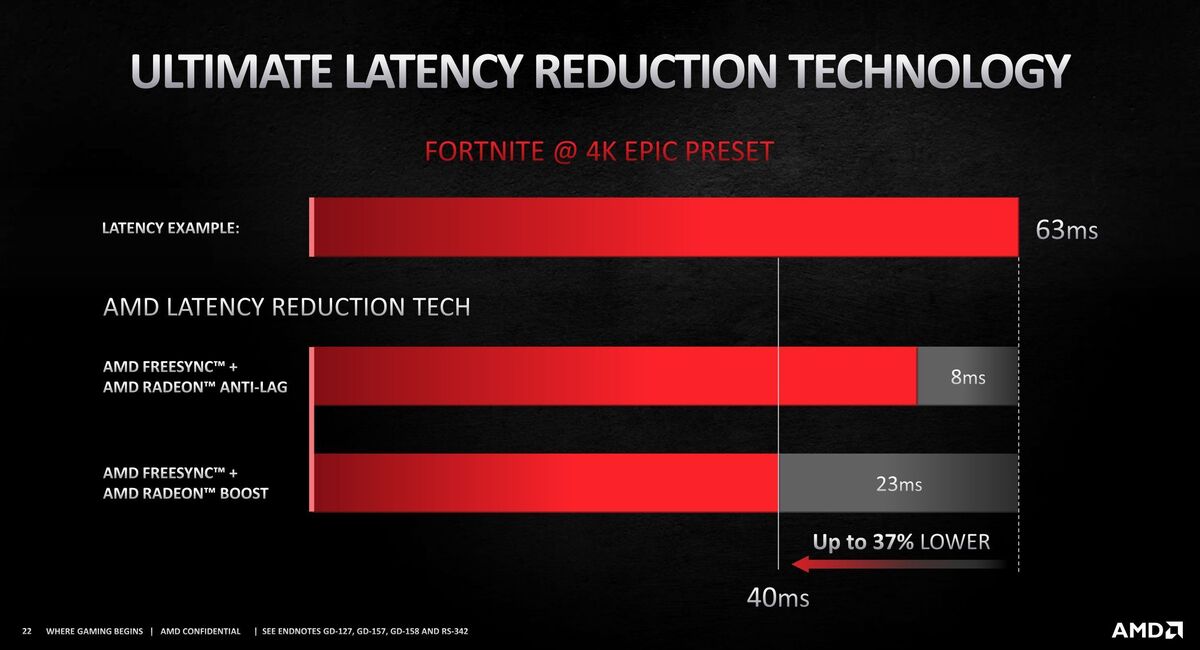 AMD
AMD Speech production of Radeon Software features, AMD also briefly teased how its existing "Radeon Boost" and "Radeon Anti-Lag" features combine to improve latency in games that demand quick responses, especially when paired with a FreeSync ride herd on. GeForce cards just gained the Nvidia Reflex entourage of reaction time boosting features, so information technology's crystal clear that game responsiveness is becoming a new battleground for graphics card makers.
 AMD
AMD At long last, like the GeForce RTX 30-series, AMD's Radeon 6000 graphics cards will be fully DirectX 12 Eventual-compliant. Microsoft calls DX12 "a force multiplier factor for the entire gaming ecosystem" by unifying an array of new features—by and large ones introduced in Nvidia's RTX 20-series, but largely ignored by developers—across all PC and next-gen Xbox hardware. "When Xbox Series X releases, there bequeath already be many a millions of DX12 Last Microcomputer graphics cards in the world with the same feature set, catalyzing a rapid adoption of new features, and when Xbox Series X brings a wave of new console gamers, PC will besides benefit from this vast surge of new DX12 Eventual capable hardware," Microsoft aforesaid when announcing the API.
Existence DirectX 12 Ultimate-conformable agency the Radeon RX 6000 graphics cards will support variable value shading, mesh shading, sampler feedback, and yes, true-time ray tracing—though AMD didn't go into inside information about its hotly anticipated ray tracing carrying out.
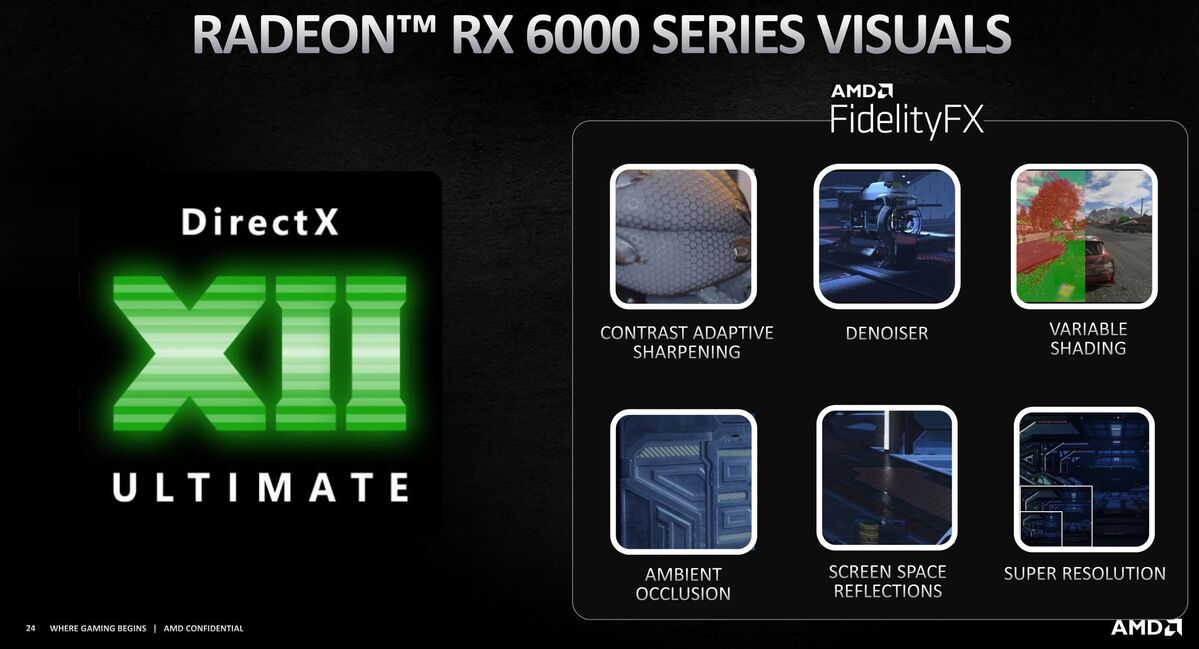 AMD
AMD AMD wasn't completely mum, though. Nvidia has a sack lead on ray trace, and the troupe's proprietorship Deep Eruditeness Superintendent Sampling (DLSS) plays a big role. The AI upscaling feature leverages the dedicated tensor cores in GeForce GPUs to speed up frame rates, counterbalancing ray trace's performance impact—but call up, IT's an Nvidia-proprietary engineering. AMD excited a solution of its own as part of the companionship's open FidelityFX tools during nowadays's presentation. Tucked away in the turning point of the slide, in that location was a small boxful that simply said "Super Resolution."
Herkelman wouldn't enter inside information, but he addicted to PCWorld that this will be AMD's open response to Nvidia's DLSS, configured to work along any graphics hardware—even Genus Apus—and across single platforms, because AMD's RDNA 2 GPUs also power the next-gen PlayStation 5 and Xbox Series X consoles.
That broad adoption of AMD technologies could be an ace in the hole for Radeon's ray tracing future. The inexperienced consoles will glucinium getting bump off the ground at roughly the same time equally the Radeon RX 6000 series, all bearing RDNA 2 GPUs. With the Radeon RX 6000 series, Xbox Series X, and even Nvidia's RTX 30-series all driving DirectX 12 Ultimate brash in the unchanged time frame equally well, AMD is betting that DX12U's features will become ubiquitous. Everyone is working connected the same page at once.
 AMD
AMD RDNA 2 isn't just for the Radeon RX 6000 graphics cards.
As the graphics chip inwardly the consoles, AMD's yet-to-be-revealed ray tracing implementation could become the standard objective for game developers despite Nvidia's two-year lead and impressive patented computer hardware. If AMD's ray tracing becomes the standard, its ASCII text file "Super Resolution" applied science wrong of FidelityFX could become the standard As asymptomatic. DLSS 2.0 is necromancy, but it's locked to Nvidia GPUs on PCs, and requires bespoke code.
Course, as with Infinity Cache and AMD Smart Access Memory, it depends happening the details. AMD isn't revealing anything more virtually Comprehensive Resolution nowadays.
Bottom air, though? Afterwards sevener long years, AMD's RDNA 2-equipped Radeon RX 6000 graphics cards are finally ready to bring the fight to Nvidia at the very butt on of enthusiast-class public presentation. We'll need to see if AMD's soaring claims withstand to scrutiny by independent testers, but we can't wait to get our hands happening these nontextual matter cards. Competition is a wonderful thing—and long overdue at the high end. Welcome spinal column, AMD.
Source: https://www.pcworld.com/article/393670/amd-radeon-rx-6000-graphics-cards-rdna-2-infinity-cache-smart-access-memory.html
Posted by: villanuevafroce1969.blogspot.com

0 Response to "AMD Radeon RX 6800, 6800 XT, and 6900 XT aim at Nvidia's best - villanuevafroce1969"
Post a Comment